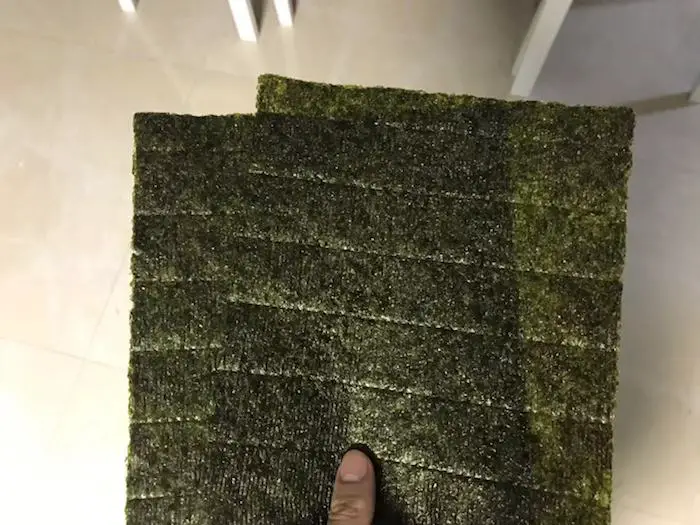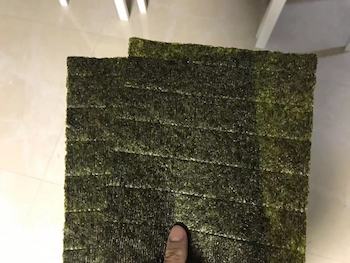We are reader supported. When you purchase through links on our site, we may earn an affiliate commission. Also, as an Amazon affiliate, we earn from qualifying purchases.

When it comes to finding the perfect balance for our nori, it can be somewhat tough. Nori is a popular edible seaweed consumed by many. Especially the Japanese. However, many who take up a fond liking for Nori, run into some everyday struggles to get it to the edible state that we can also enjoy. You may even have many questions on how to get this done correctly. I see a question pop up quite frequently. It’s simple in nature. Why is my nori so chewy? After doing some trial and error and diligent research, here is what I can tell you on the topic.
So, why is my nori so chewy? Nori will get chewy once it absorbs moisture. In most circumstances, this is going to be from the rice placed on the nori during the cooking process. Other ingredients also add to the moisture absorbed by nori which can further add to how chewy your nori ultimately becomes.
I wanted to take the time to dive into this question a bit more and give you an inside look at a few ideas and steps that you can take to make nori taste the absolute best possible. Let’s dive into some of those frequently asked questions and concerns and see if we can get you ready to go!
Contents
More About Nori
Nori merely is the Japanese name for a sea vegetable or edible form of seaweed. It comes from the species of red algae (genus pyropia). It’s key purpose and most frequently used application is to wrap or roll sushi. It can also be used to wrap onigiri. You will most commonly find nori in dry sheets in packs of ten and about 1oz of total volume. We will discuss quality of Nori later in this post.
It’s a healthy snack or item on the dinner menu consisting of 85% water, 6% protein and 5% carbohydrates. The problem that many of us run into like stated before is the nori becoming somewhat overwhelming and displeasing due to being too chewy.
The goal would be to take active measures to prevent this from happening. We will cover some active steps you can take shortly to help aid you through that process.
How Is Nori Most Often Made?
Nori is easy to make and only requires some simple nori sheets to be placed on a flat surface. It does need to be completely dry before beginning, and you will merely spread cooked sushi rice with your hands and fingers across the wrap evenly.
The steps and suggestions I’m going to illustrate below are merely tips and tricks of the trade that can help you eliminate the chances of your nori ending up too chewy when you are finished with prepping and cooking.
Top Ways to Avoid Your Nori from Being Too Chewy
My focus today was to help inform you of some helpful tips that may help your nori reduce some of the chewiness and get it to a more enjoyable state for eating. Here are some of the top suggestions.
Avoid Waiting too Long to Eat Nori
Most individuals who enjoy nori will tell you that your best bet it eat nori and sushi quickly after you roll it. If you held it over a heat source and rolled it with rice, it doesn’t take very long for the nori to absorb the moistures from the rice and begin to become chewy. Eating it quickly will eliminate this issue for you.
Learn to Wrap and Peel Nori in One Motion/Step
Another method is to wrap your nori with onigiri while peeling off the plastic in one motion. Doing so will allow you to prepare it and eat it quickly enough that you won’t have to run into the issue of the nori becoming overly chewy.
Just remember when preparing and eating nori that it all comes down to time. The faster you consume it, the better off you will be. Assuming all other factors are equal of course.
Avoid Using Too Moist of Rice
Some individuals also state that sometimes it’s not how fast you consume the nori but the rice itself while being rolled may contain too much moisture which can amplify the issue, providing too much moisture and ultimately making your nori too chewy.
You can help solve this issue by avoiding under-drying your rice. If your rice is extra sticky, you may want to add some dry time to help make the finished product that much more enjoyable.
Related Article: How to Make Sushi Rice More Sticky?
Aim for Higher Quality Nori, It Won’t Disappoint
This solution seems straightforward if you ask me. Avoid purchasing the bottom of the barrel nori and rice. The more high-end nori will usually be thinner and after exposure to a heat source will become very nice and crispy.
Most would agree that the better way to go about this is by purchasing Japanese Seaweed instead of the Chinese Seaweed.
Many individuals underestimate the quality of nori and how much it can differ or impact the final product and quality. It’s known that nori is produced in Korea and China, but some of the best nori in the world comes from Ariake Bay which is the island of Kyishu in Japan.
Everything from location, currents, and water temperature can play a role in the overall quality of the nori you are consuming, so it’s important to try and aim for better quality if you are a picky eater and are trying desperately to avoid nori that is overly chewy.
Never Skip Torching Your Nori
This is the easiest method of them all. Especially if you use an electric or even gas range. Just use the range as a heat source and flip each side quickly while holding the nori. It only takes a moment to take the thin piece of nori and make it nice and crispy. If you consume the nori shortly after this step, you shouldn’t have much of an issue with the nori being overly chewy.
Minimize Liquid When Cooking Your Rice
Reducing the total amount of liquid, you use when preparing your rice has been shown repeatedly to help eliminate the chewy factor from nori.
In addition, after preparation, never leave your nori out in the open for long periods of time before consuming. This can be a remedy for disaster. Sitting in the open is going to be the hot spot for air and moisture to penetrate the nori and get you right back to where you feel like you are eating bubblegum. Not a good situation for anyone.
Bang Your Rice Bag on An Old Backyard Tree
Okay, this one may seem a little bit odd, but it seems to be a popular choice for removing moisture from the rice which ultimately will reduce the moisture that is transferred to your nori. The ending product is obvious. Less chewy nori.
Your Hands Carry Moisture. Don’t Forget That
Keep in mind that when rolling your rice in a nori roll, your hands also carry moisture. Ensuring your hands are dry and the rice remains completely dry is a great way to make sure too much moisture isn’t transferred to the nori. Give this a try and see if it provides a better final product.
Putting It All Together, Take Small Steps to Improve Your Nori Quality
I’ve struggled with nori being chewy as well, so I get it. It can be tough to find that perfect sweet spot to get the job done. A few small steps and preparation to eliminate additional moisture can go a long way towards making your nori crisper and more enjoyable.
It may take some trial and error to finally perfect your formula, but it can certainly be done. Avoid cheaper nori and always be sure to expose your nori to a heat source and you are well on your way. What’s your experience with eliminating moisture from your Nori? How did you get your nori not to be so chewy? Drop a comment below.
Related Questions
How Do You Store Nori After Opening?
We have already discussed how nori seaweed grabs moisture very quickly. This makes it imperative to ensure that after the bag has been opened that you always squeeze the air out from the plastic bag and in most situations, you want to eat/enjoy your nori as soon as possible after beginning the process or opening the package.
In most circumstances, nori is only going to last you about 2-3 weeks after it’s been opened, and this is also assuming that you keep it in a cool place with low humidity levels.
Does Walmart Have Nori?
Yes. Walmart does sell Nori. I personally haven’t used it, but the common brand that Walmart offers is the Roland Nori, Dried Seaweed Sheets. They come in a 10 count or 1 oz packages.
Related Article: What is the Difference Between Kombu and Nori?
Is Nori Refrigerated?
No. Nori is not refrigerated, and it would not be a good idea to do so either. Nori will gain plenty of additional moisture by being refrigerated which defeats the purpose of trying to eliminate the chewy factor in the first place.
The best method is just to reseal the nori in its an original container or use a Ziploc bag. Some individuals will even use a sealed glass jar to get the job done. Another trick I’ve seen is using the “do not eat” package of silica gel that can help absorb further moisture from taking place and keep your nori tasting much fresher when it comes time to prepare it.


Comments
Pingback: What Kind Of Seaweed Is Used For Sushi? - Easy Homemade Sushi